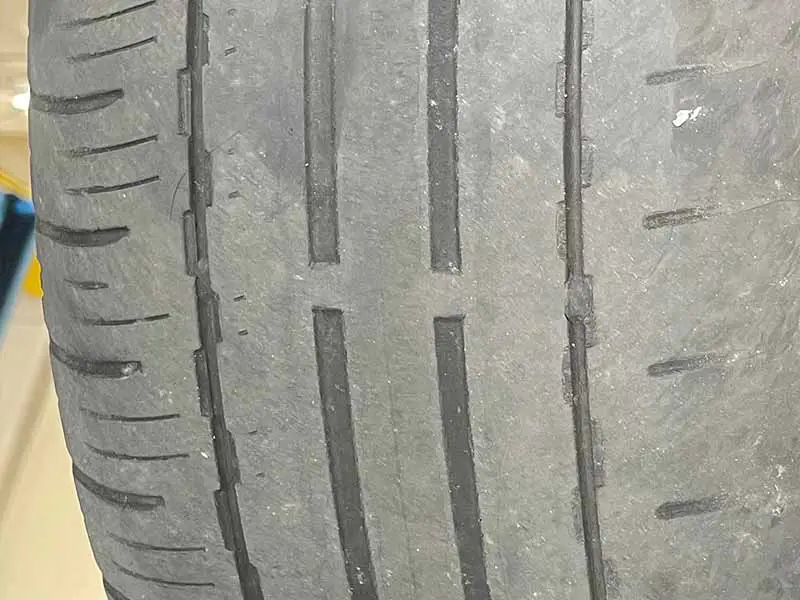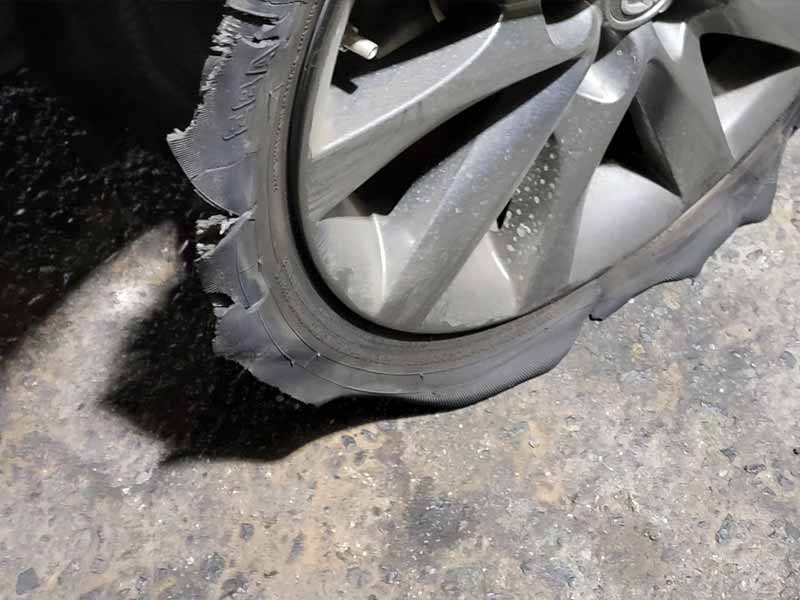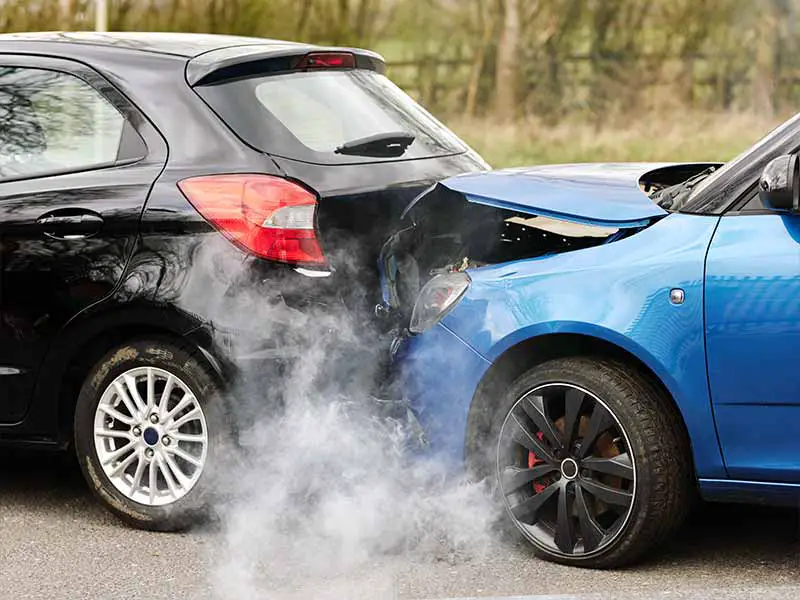If you’re reading this article, chances are you just realized your worn tires are more than worn – they are actually worn-out tires.
Now you’re wondering “Is it safe to drive on bald tires?” You probably know the answer, but want to know just how bad driving on bald tires really is.
Are Bald Tires Dangerous?
Bald tires increase the risk of losing control of your vehicle dramatically on wet roads. Stopping distance can more than double and hydroplaning can occur at speeds as low as 35 mph, and worn-out tires are far more likely to puncture and cause a catastrophic blowout.
Additionally, if you are involved in an accident while driving on bald tires, you can be ticketed or even found at fault.
At this point, many may be thinking that this is an exaggeration in an attempt to sell a set of tires. Well, we don’t sell tires at TireGrades.com. We provide helpful and accurate information. That’s our mission.
According to an National Traffic Safty Board (NTSB) study “Each year, about 33,000 tire-related passenger vehicle crashes occur” and “poor tire maintenance practices by consumers” is one of the primary causes cited.
Let’s take a closer look.

Will Bald Tires Blow Out?
Bald tires increase the risk of a flat tire. Tire blowouts are more likely because blad tires can be more easily punctured. The remaining tread is very thin and is less likely to prevent punctures from penetrating all the way through the tire instead of getting lodged in a tread block.
We often aren’t aware of the damage that occurs to our tires when the tread depth is much greater. This is because picking up a short nail or screw won’t actually cause the tire to lose air pressure since it often doesn’t do any real damage.
When the rubber between the road surface and pressurized inside of your tire is unusually thin, the chance of tire failure from a catastrophic blowout, or even simply losing tire pressure and suffering a flat tire, are at a much more increased risk.
A simple flat tire is an inconvenience and can leave you stranded in dangerous situations. But sudden blowouts can mean losing control of your car or truck and potentially leading to an accident.

Hydroplaning – Bald Tires In Rain
Hydroplaning is an extremely dangerous situation where your tires lose traction on wet roads by lifting up and gliding on top of the water on the road surface. The sensation is similar to hitting a patch of ice.
Hydroplaning is possible no matter how much tire tread depth you have or how new your tires may be. Speed causes hydroplaning more than tread depth. But your tire’s tread makes a huge difference in how much speed will cause you to hydroplane and lose vehicle control.
Hydroplaning can occur at speeds as low as 35 mph on worn tires. New tires can resist hydroplaning at highway speeds under most normal wet road surface conditions you may encounter.
Stopping Distance In Wet Conditions
Panic-braking for emergency situations in wet weather will increase stopping distances compared to dry roads no matter how much tread depth your tires may have.
When driving on bald tires your tire tread has worn down to 2/32″ or less. At this point, the tire grooves in your tread pattern are extremely shallow and can no longer adequately channel water out from under the contact patch of the tires.
Bald tires can take twice the distance or more to come to a complete stop even with the best antilock brakes and traction control systems on wet roads when compared to new tires.
How Bald Is Too Bald For Tires?
The legal minimum tread depth according to most state’s laws is 2/32″. At this point, your tire’s tread has worn down to even with the wear bars and there is very little tread left to channel water out from underneath the contact patch of your tires.
Bald tires (any tires with 2/32″ of tire tread or less) are completely worn and should be replaced immediately.
Low tread tires such as those from 3/32″ to 4/32″ of a tire tread may not be required to be replaced but are considered worn-out tires by many. While not required, it is recommended by most tire professionals that you replace your tires by the time they reach 4/32″ of tire tread. This is to help maintain better hydroplane resistance and shorter stopping distances in rainy conditions.
How Long Can You Drive On A Bald Tire?
You should never consider driving on bald tires. In fact, it is illegal to be caught driving on bald tires in most states.
Bald tires increase the opportunity of losing control and skidding off the road or into another vehicle. Less traction from bald tires can’t be overcome with driving skills.
Driving on bald tires is like Russian Roulette. You never know when you’ll be in a situation where you try to come to a sudden stop and find yourself skidding through an intersection or into a ditch.
How To Tell If Your Tires Are Bald
There are a few methods to determine if you’re driving on bald tires or tires that have poor enough tread wear to be considered bald tires.
Wear Bars
Wear bars are small bumps molded into the deep grooves of your tire’s tread pattern. These wear indicators are 2/32″ in height. This means that once the top of your tire tread wears to the point that it is flush with the wear bar, your tires are worn out and should be replaced.
Penny Test
The penny test is a convenient method of checking your tire tread with a bit more accuracy than a visual inspection of the wear bars.
- Place a penny upside down in the deep tread grooves between tread ribs.
- If all of Lincoln’s head is visible you should replace your tires immediately.
- If all of Lincoln’s forehead is visible, you should consider replacing your tires soon.
- If part of Lincoln’s forehead is obscured by your tire treads, your tread is at an acceptable depth.
Tread Depth Gauge
Worn tires can be accurately checked to see how much tread remains with a tread depth gauge.
- Insert the probe of your gauge in one of the main grooves in your tire tread design pattern.
- Push down on the top of the gauge until the shoulders of the gauge come to rest on top of the tread blocks and the probe contacts the bottom of the tread groove.
- Remove the gauge from the top of the tread, being careful to not nudge the probe, to read the measurement.
- Repeat the process at several points around the circumference and width of the tire.
How To Make Tires Last Longer
Whether you have just purchased a set of new tires, or you want to be sure you get the most out of your current worn tires, proper tire maintenance is important.
Tires are expensive and making them last as long as possible isn’t difficult or expensive. Here are the basics to keep in mind:
AIR PRESSURE
Maintaining proper tire pressure is extremely important to ensure your tires wear evenly and last as long as possible.
Tire pressure monitoring systems (TPMS) are designed to alert you when your air pressure drops by more than 25%. This means you could have been driving on underinflated tires for months before the TPMS provides an alert.
The National Highway Traffic Safety Administration (NHTSA) recommends checking your tire pressure monthly. I realize many drivers won’t do this, but if you can take a moment to check your tire’s air pressures every 3 months at least, your tires will last much longer.
WHEEL ALIGNMENT
Misalignment of suspension geometry is the primary cause of many uneven tire wear patterns and is responsible for causing worn-out tires.
It’s recommended that you have your wheels aligned every 10,000 miles to prevent uneven wear that will rapidly cause a bald tire due to a portion of the tread being completely worn.
TIRE ROTATION
Regular tire rotation is important for maintaining the tire manufacturer’s warranty and mileage guarantee. It will also help ensure your tires wear as evenly as possible.
It’s recommended that you rotate your tires every 5,000 miles since this will meet or exceed the requirements of most tire manufacturers and better distribute the unique tire wear patterns of each tire position to every tire.
TIRE BALANCE
Balancing wheel and tire assemblies should be performed regularly since tires can lose balance as they become worn. Wheels can also become unbalanced due to curb strikes and potholes or losing wheel weights over time.
Out-of-balance tires can cause uneven wear known as cupping. Balance issues can also cause steering wheel vibration or vibrations felt through the seat or the floorboard of your car or truck.
SUSPENSION COMPONENT WEAR
Potholes and curb strikes not only damage rims, but they can damage suspension components and cause problems with wheel alignment.
Even the best driver that managed to avoid every pothole and curb will still experience worn suspension components over time.
Control arm bushings and worn shocks can cause uneven wear that can cause a prematurely bald tire.
Resources
Below are some links you may find helpful when learning about tires
- How safe are worn tires – Consumer Reports
- Can bald or worn out tires get you a traffic ticket? – The Press-Enterprise
Final Thoughts
Bald tires perform just fine on sunny days but are ticking time bombs. Bald tires can put you in dangerous situations when you aren’t prepared.
Driving on bald tires and dry roads won’t set off any alarm bells for most people, but if you’re suddenly caught in a rain storm or have a sudden loss of air pressure due to a puncture, it’s too late.
Replace your worn tires in a timely manner and stay on top of proper tire maintenance when you purchase your new tires to get the most value from your hard-earned cash.
Good luck and happy motoring.







